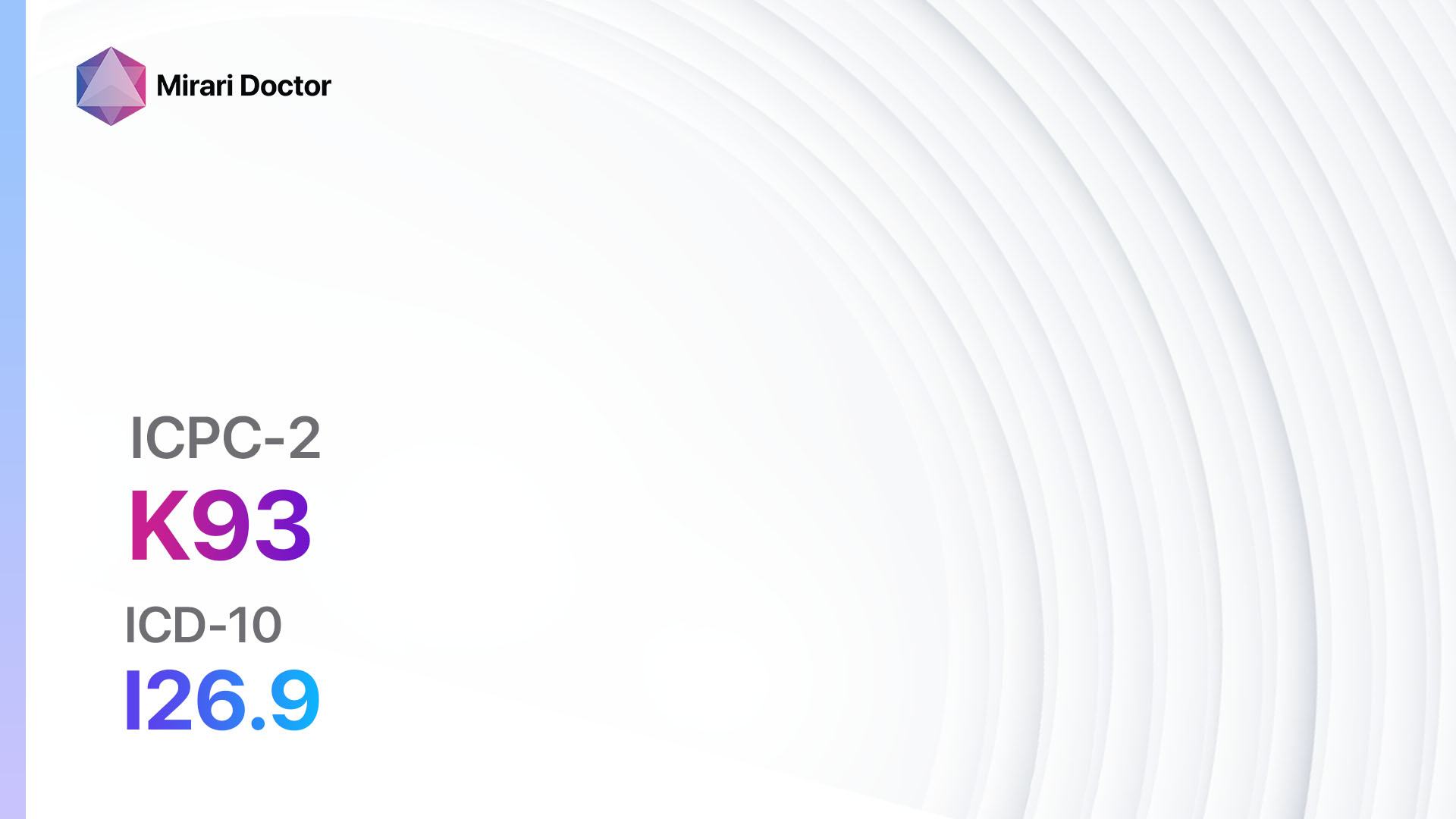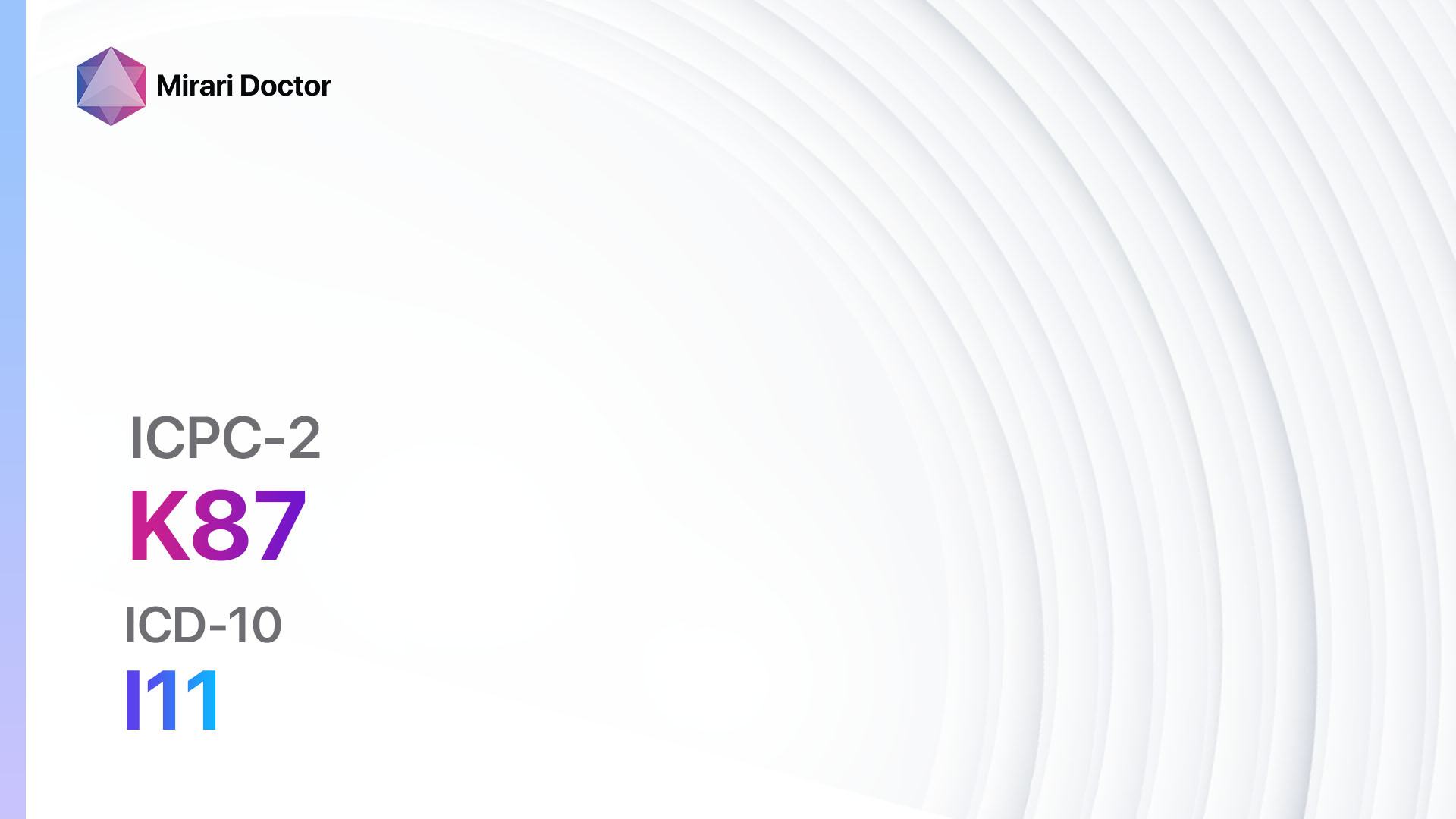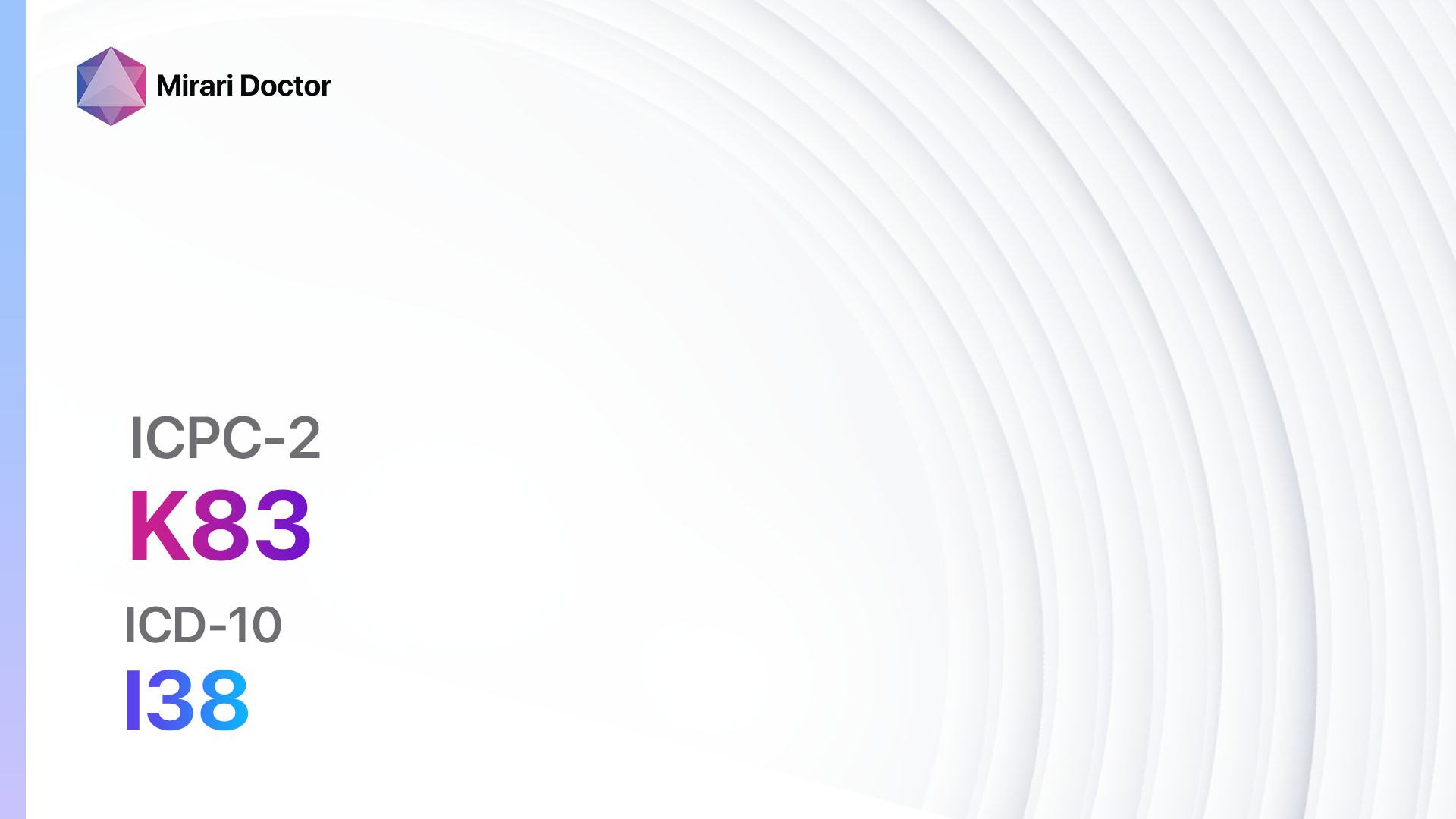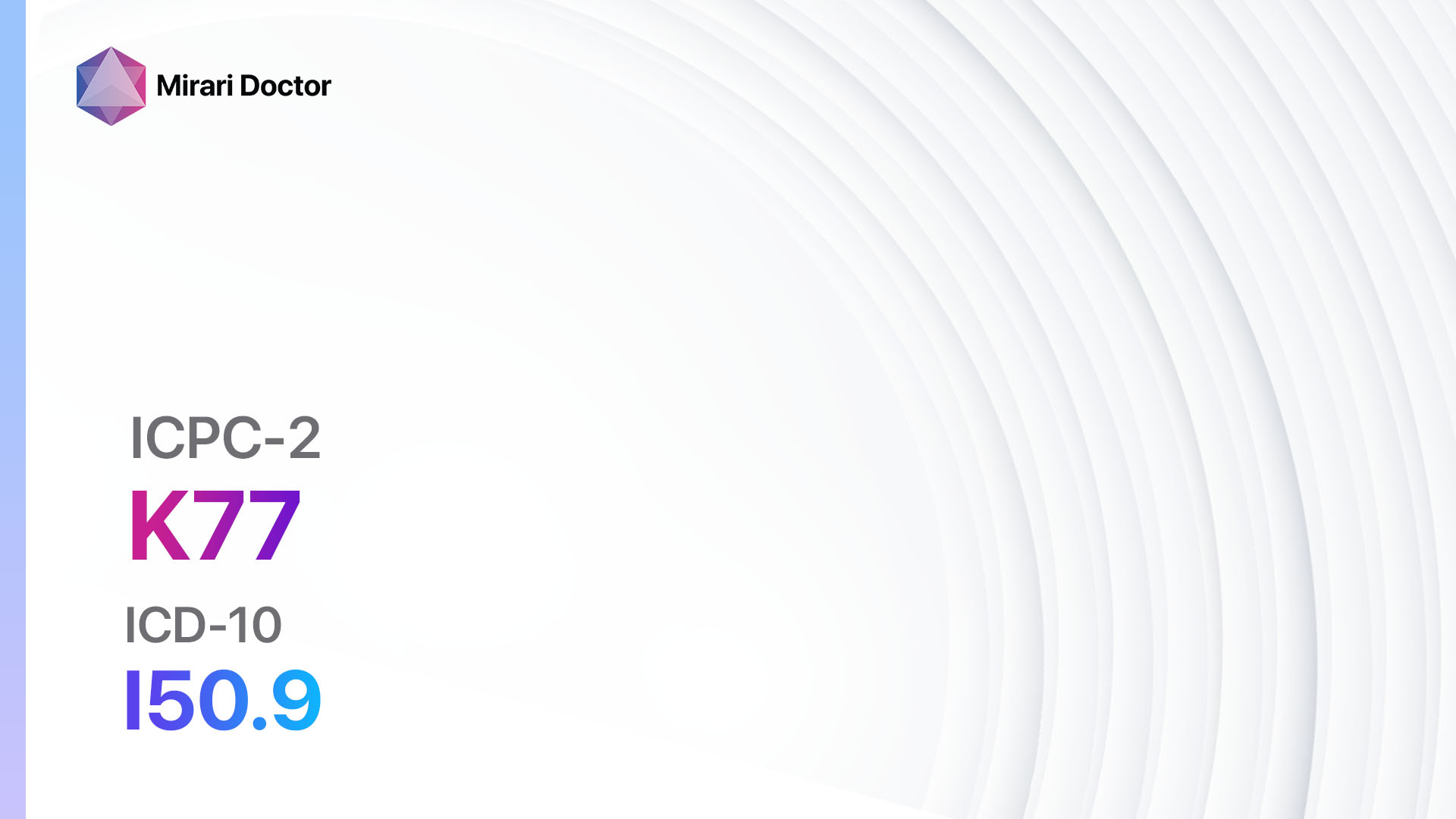
Introduction
Atrial fibrillation/flutter is a common cardiac arrhythmia characterized by irregular and rapid heartbeats. It can lead to various complications, including stroke, heart failure, and other cardiovascular diseases[1][2]. The aim of this guide is to provide healthcare professionals with a comprehensive overview of the diagnosis and management of atrial fibrillation/flutter.
Codes
Symptoms
- Palpitations: Sensation of a rapid, fluttering, or pounding heartbeat[3].
- Fatigue: Feeling tired or exhausted[4].
- Shortness of breath: Difficulty breathing or catching breath[5].
- Dizziness or lightheadedness: Feeling faint or woozy[6].
- Chest pain or discomfort: Uncomfortable pressure, squeezing, or pain in the chest[7].
- Weakness: Lack of strength or energy[8].
Causes
- Age: Risk increases with age, especially over 60 years old[9].
- High blood pressure: Hypertension can contribute to the development of atria lfibrillation/flutter[10].
- Heart diseases: Conditions such as coronary artery disease, heart valve problems, and congenital heart defects can increase the risk.
- Thyroid problems: Overactive thyroid gland (hyperthyroidism) can trigger atrial fibrillation/flutter.
- Chronic conditions: Diabetes, sleep apnea, and chronic kidney disease are associated with a higher risk.
- Alcohol and drug use: Excessive alcohol consumption and illicit drug use can contribute to the development of atrial fibrillation/flutter.
Diagnostic Steps
Medical History
- Gather information about the patient’s symptoms, including the frequency, duration, and severity.
- Assess the patient’s medical history, including any previous heart conditions, surgeries, or procedures.
- Identify risk factors such as age, hypertension, diabetes, and thyroid problems.
- Inquire about the use of medications, alcohol, and illicit drugs.
Physical Examination
- Measure the patient’s blood pressure, heart rate, and rhythm.
- Auscultate the heart to detect any abnormal sounds or murmurs.
- Palpate the peripheral pulses to assess for irregularities.
- Examine the neck veins for signs of congestion or fluid retention.
- Evaluate the patient’s overall cardiovascular status, including signs of heart failure.
Laboratory Tests
- Complete blood count (CBC): Assess for anemia or other blood disorders.
- Thyroid function tests: Measure thyroid hormone levels to rule out hyperthyroidism.
- Electrolyte panel: Check for imbalances that may contribute to arrhythmias.
- Kidney function tests: Evaluate renal function, as impaired kidney function can increase the risk of atrial fibrillation/flutter.
- Liver function tests: Assess liver health, as liver disease can affect the metabolism of medications used to treat atrial fibrillation/flutter.
- Coagulation profile: Determine the patient’s clotting ability, as atrial fibrillation/flutter increases the risk of blood clots.
Diagnostic Imaging
- Electrocardiogram (ECG): The primary diagnostic tool for atrial fibrillation/flutter, it records the electrical activity of the heart.
- Echocardiogram: Uses ultrasound waves to visualize the heart’s structure and function, helping to identify any underlying heart diseases.
- Chest X-ray: May be performed to assess the size and shape of the heart and detect any signs of heart failure or lung disease.
- Holter monitor: A portable ECG device worn by the patient for 24-48 hours to record heart rhythm continuously.
- Event monitor: Similar to a Holter monitor, but worn for a longer period of time (up to 30 days) to capture intermittent arrhythmias.
Other Tests
- Stress test: Evaluates the heart’s response to physical activity, helping to identify exercise-induced arrhythmias.
- Transesophageal echocardiogram (TEE): Uses a specialized probe inserted into the esophagus to obtain detailed images of the heart’s chambers and valves.
- Cardiac catheterization: Invasive procedure to assess the coronary arteries and measure pressures within the heart.
- Genetic testing: Consider in cases of early-onset atrial fibrillation/flutter or a family history of the condition.
Follow-up and Patient Education
- Schedule regular follow-up appointments to monitor the patient’s condition and adjust treatment as necessary.
- Educate the patient about the importance of medication adherence and lifestyle modifications.
- Provide information on potential complications, such as stroke, and the need for anticoagulation therapy.
- Encourage the patient to seek medical attention if symptoms worsen or new symptoms develop.
Possible Interventions
Traditional Interventions
Medications:
Top 5 drugs for Atrial fibrillation/flutter:
- Antiarrhythmic agents (e.g., Amiodarone, Flecainide):
- Cost: Amiodarone – $10-$100/month, Flecainide – $20-$200/month.
- Contraindications: Severe bradycardia, heart block, liver or lung disease.
- Side effects: Fatigue, dizziness, nausea.
- Severe side effects: Pulmonary toxicity, liver toxicity, proarrhythmia.
- Drug interactions: Many potential drug interactions, including other antiarrhythmics and medications that prolong the QT interval.
- Warning: Regular monitoring of thyroid and liver function is required.
- Beta-blockers (e.g., Metoprolol, Atenolol):
- Cost: Generic versions are typically <$30/month.
- Contraindications: Severe bradycardia, heart block, uncontrolled heart failure.
- Side effects: Fatigue, dizziness, bradycardia.
- Severe side effects: Bronchospasm, heart block.
- Drug interactions: Calcium channel blockers, insulin.
- Warning: Should not be abruptly stopped.
- Calcium channel blockers (e.g., Diltiazem, Verapamil):
- Cost: Generic versions can be $10-$50/month.
- Contraindications: Severe bradycardia, heart block, heart failure.
- Side effects: Dizziness, headache, constipation.
- Severe side effects: Heart block, low blood pressure.
- Drug interactions: Beta-blockers, grapefruit juice.
- Warning: Monitoring of heart rate and blood pressure is required.
- Anticoagulants (e.g., Warfarin, Apixaban):
- Cost: Warfarin – $4-$20/month, Apixaban – $400-$500/month.
- Contraindications: Active bleeding, history of intracranial hemorrhage.
- Side effects: Increased risk of bleeding.
- Severe side effects: Major bleeding, allergic reactions.
- Drug interactions: Many potential drug interactions, including other anticoagulants and antiplatelet agents.
- Warning: Regular monitoring of INR (International Normalized Ratio) is required for patients on warfarin.
- Digoxin:
- Cost: $10-$50/month.
- Contraindications: Ventricular fibrillation, hypersensitivity.
- Side effects: Nausea, vomiting, visual disturbances.
- Severe side effects: Ventricular arrhythmias, heart block.
- Drug interactions: Many potential drug interactions, including other antiarrhythmics and medications that affect potassium levels.
- Warning: Regular monitoring of digoxin levels is required.
Alternative Drugs:
- Direct oral anticoagulants (DOACs) (e.g., Dabigatran, Rivaroxaban): Offer an alternative to warfarin with fewer drug interactions and less need for monitoring.
- Amiodarone: Can be used for rhythm control in patients with structural heart disease or heart failure.
- Sotalol: A non-selective beta-blocker with class III antiarrhythmic properties.
- Propafenone: A class IC antiarrhythmic agent used for rhythm control.
Surgical Procedures:
- Catheter ablation: A minimally invasive procedure that targets and destroys the abnormal heart tissue responsible for the arrhythmia.
- Cost: $15,000 to $50,000.
- Maze procedure: An open-heart surgery that creates scar tissue to redirect electrical signals and restore normal heart rhythm.
- Cost: $70,000 to $200,000.
- Pacemaker implantation: In cases of bradycardia or heart block, a pacemaker can be implanted to regulate the heart rate.
- Cost: $20,000 to $50,000.
Alternative Interventions
- Acupuncture: May help improve symptoms and reduce the frequency of atrial fibrillation/flutter episodes.
- Cost: $60-$120 per session.
- Yoga and meditation: Can help reduce stress and promote relaxation, potentially reducing the occurrence of arrhythmias.
- Cost: Varies depending on the location and instructor.
- Herbal supplements: Some herbs, such as hawthorn, motherwort, and valerian, have been used traditionally to support heart health.
- Cost: Varies depending on the specific supplement.
- Omega-3 fatty acids: Found in fish oil supplements, omega-3 fatty acids have been shown to have antiarrhythmic effects.
- Cost: $10-$30 per month.
- Biofeedback therapy: Teaches patients to control their heart rate and rhythm through relaxation techniques and mental focus.
- Cost: $50-$150 per session.
Lifestyle Interventions
- Healthy diet: Encourage a diet rich in fruits, vegetables, whole grains, lean proteins, and low-fat dairy products.
- Cost: Varies depending on food choices and dietary preferences.
- Regular exercise: Recommend at least 150 minutes of moderate-intensity aerobic activity per week.
- Cost: Varies depending on the chosen form of exercise (e.g., gym membership, equipment).
- Stress management: Encourage stress reduction techniques such as deep breathing, meditation, and mindfulness.
- Cost: Varies depending on the chosen method (e.g., meditation app subscription, yoga classes).
- Limit alcohol and caffeine: Advise patients to moderate their alcohol consumption and limit caffeine intake.
- Cost: Varies depending on individual habits and preferences.
- Smoking cessation: Support patients in quitting smoking, as smoking is a significant risk factor for atrial fibrillation/flutter.
- Cost: Varies depending on the chosen smoking cessation method (e.g., nicotine replacement therapy, counseling).
It is important to note that the cost ranges provided are approximate and may vary depending on the location and availability of the interventions.
Mirari Cold Plasma Alternative Intervention
Understanding Mirari Cold Plasma
- Safe and Non-Invasive Treatment: Mirari Cold Plasma is a safe and non-invasive treatment option for various skin conditions. It does not require incisions, minimizing the risk of scarring, bleeding, or tissue damage.
- Efficient Extraction of Foreign Bodies: Mirari Cold Plasma facilitates the removal of foreign bodies from the skin by degrading and dissociating organic matter, allowing easier access and extraction.
- Pain Reduction and Comfort: Mirari Cold Plasma has a local analgesic effect, providing pain relief during the treatment, making it more comfortable for the patient.
- Reduced Risk of Infection: Mirari Cold Plasma has antimicrobial properties, effectively killing bacteria and reducing the risk of infection.
- Accelerated Healing and Minimal Scarring: Mirari Cold Plasma stimulates wound healing and tissue regeneration, reducing healing time and minimizing the formation of scars.
Mirari Cold Plasma Prescription
Video instructions for using Mirari Cold Plasma Device – K78 Atrial fibrillation/flutter (ICD-10:I48)
| Mild | Moderate | Severe |
| Mode setting: 1 (Infection) Location: 5 (Lungs) Morning: 15 minutes, Evening: 15 minutes |
Mode setting: 1 (Infection) Location: 5 (Lungs) Morning: 30 minutes, Lunch: 30 minutes, Evening: 30 minutes |
Mode setting: 1 (Infection) Location: 5 (Lungs) Morning: 30 minutes, Lunch: 30 minutes, Evening: 30 minutes |
| Mode setting: 2 (Wound Healing) Location: 5 (Lungs) Morning: 15 minutes, Evening: 15 minutes |
Mode setting: 2 (Wound Healing) Location: 5 (Lungs) Morning: 30 minutes, Lunch: 30 minutes, Evening: 30 minutes |
Mode setting: 2 (Wound Healing) Location: 5 (Lungs) Morning: 30 minutes, Lunch: 30 minutes, Evening: 30 minutes |
| Mode setting: 7 (Immunotherapy) Location: 1 (Sacrum) Morning: 15 minutes, Evening: 15 minutes |
Mode setting: 7 (Immunotherapy) Location: 1 (Sacrum) Morning: 30 minutes, Lunch: 30 minutes, Evening: 30 minutes |
Mode setting: 7 (Immunotherapy) Location: 1 (Sacrum) Morning: 30 minutes, Lunch: 30 minutes, Evening: 30 minutes |
| Mode setting: 7 (Immunotherapy) Location: 4 (Heart, Bile & Pancreas) Morning: 15 minutes, Evening: 15 minutes |
Mode setting: 7 (Immunotherapy) Location: 4 (Heart, Bile & Pancreas) Morning: 30 minutes, Lunch: 30 minutes, Evening: 30 minutes |
Mode setting:7 (Immunotherapy) Location: 4 (Heart, Bile & Pancreas) Morning: 30 minutes, Lunch: 30 minutes, Evening: 30 minutes |
| Total Morning: 60 minutes approx. $10 USD, Evening: 60 minutes approx. $10 USD |
Total Morning: 120 minutes approx. $20 USD, Lunch: 120 minutes approx. $20 USD, Evening: 120 minutes approx. $20 USD, |
Total Morning: 120 minutes approx. $20 USD, Lunch: 120 minutes approx. $20 USD, Evening: 120 minutes approx. $20 USD, |
| Usual treatment for 7-60 days approx. $140 USD – $1200 USD | Usual treatment for 6-8 weeks approx. $2,520 USD – $3,360 USD |
Usual treatment for 3-6 months approx. $5,400 USD – $10,800 USD
|
 |
|
Use the Mirari Cold Plasma device to treat Atrial fibrillation/flutter effectively.
WARNING: MIRARI COLD PLASMA IS DESIGNED FOR THE HUMAN BODY WITHOUT ANY ARTIFICIAL OR THIRD PARTY PRODUCTS. USE OF OTHER PRODUCTS IN COMBINATION WITH MIRARI COLD PLASMA MAY CAUSE UNPREDICTABLE EFFECTS, HARM OR INJURY. PLEASE CONSULT A MEDICAL PROFESSIONAL BEFORE COMBINING ANY OTHER PRODUCTS WITH USE OF MIRARI.
Step 1: Cleanse the Skin
- Start by cleaning the affected area of the skin with a gentle cleanser or mild soap and water. Gently pat the area dry with a clean towel.
Step 2: Prepare the Mirari Cold Plasma device
- Ensure that the Mirari Cold Plasma device is fully charged or has fresh batteries as per the manufacturer’s instructions. Make sure the device is clean and in good working condition.
- Switch on the Mirari device using the power button or by following the specific instructions provided with the device.
- Some Mirari devices may have adjustable settings for intensity or treatment duration. Follow the manufacturer’s instructions to select the appropriate settings based on your needs and the recommended guidelines.
Step 3: Apply the Device
- Place the Mirari device in direct contact with the affected area of the skin. Gently glide or hold the device over the skin surface, ensuring even coverage of the area experiencing.
- Slowly move the Mirari device in a circular motion or follow a specific pattern as indicated in the user manual. This helps ensure thorough treatment coverage.
Step 4: Monitor and Assess:
- Keep track of your progress and evaluate the effectiveness of the Mirari device in managing your Atrial fibrillation/flutter. If you have any concerns or notice any adverse reactions, consult with your health care professional.
Note
This guide is for informational purposes only and should not replace the advice of a medical professional. Always consult with your healthcare provider or a qualified medical professional for personal advice, diagnosis, or treatment. Do not solely rely on the information presented here for decisions about your health. Use of this information is at your own risk. The authors of this guide, nor any associated entities or platforms, are not responsible for any potential adverse effects or outcomes based on the content.
Mirari Cold Plasma System Disclaimer
- Purpose: The Mirari Cold Plasma System is a Class 2 medical device designed for use by trained healthcare professionals. It is registered for use in Thailand and Vietnam. It is not intended for use outside of these locations.
- Informational Use: The content and information provided with the device are for educational and informational purposes only. They are not a substitute for professional medical advice or care.
- Variable Outcomes: While the device is approved for specific uses, individual outcomes can differ. We do not assert or guarantee specific medical outcomes.
- Consultation: Prior to utilizing the device or making decisions based on its content, it is essential to consult with a Certified Mirari Tele-Therapist and your medical healthcare provider regarding specific protocols.
- Liability: By using this device, users are acknowledging and accepting all potential risks. Neither the manufacturer nor the distributor will be held accountable for any adverse reactions, injuries, or damages stemming from its use.
- Geographical Availability: This device has received approval for designated purposes by the Thai and Vietnam FDA. As of now, outside of Thailand and Vietnam, the Mirari Cold Plasma System is not available for purchase or use.
References
- January CT, Wann LS, Alpert JS, et al. 2014 AHA/ACC/HRS guideline for the management of patients with atrial fibrillation: a report of the American College of Cardiology/American Heart Association Task Force on Practice Guidelines and the Heart Rhythm Society. J Am Coll Cardiol. 2014;64(21):e1-e76.
- Kirchhof P, Benussi S, Kotecha D, et al. 2016 ESC Guidelines for the management of atrial fibrillation developed in collaboration with EACTS. Eur Heart J. 2016;37(38):2893-2962.
- Fuster V, Rydén LE, Cannom DS, et al. ACC/AHA/ESC 2006 Guidelines for the Management of Patients with Atrial Fibrillation: a report of the American College of Cardiology/American Heart Association Task Force on Practice Guidelines and the European Society of Cardiology Committee for Practice Guidelines (Writing Committee to Revise the 2001 Guidelines for the Management of Patients With Atrial Fibrillation): developed in collaboration with the European Heart Rhythm Association and the Heart Rhythm Society. Circulation. 2006;114(7):e257-354.
- Camm AJ, Kirchhof P, Lip GY, et al. Guidelines for the management of atrial fibrillation: the Task Force for the Management of Atrial Fibrillation of the European Society of Cardiology (ESC). Eur Heart J. 2010;31(19):2369-2429.
- Wann LS, Curtis AB, January CT, et al. 2011 ACCF/AHA/HRS focused update on the management of patients with atrial fibrillation (Updating the 2006 Guideline): a report of the American College of Cardiology Foundation/American Heart Association Task Force on Practice Guidelines. J Am Coll Cardiol. 2011;57(2):223-242.
- Calkins H, Kuck KH, Cappato R, et al. 2012 HRS/EHRA/ECAS expert consensus statement on catheter and surgical ablation of atrial fibrillation: recommendations for patient selection, procedural techniques, patient management and follow-up, definitions, endpoints, and research trial design. Heart Rhythm. 2012;9(4):632-696.e21.
- Calkins H, Hindricks G, Cappato R, et al. 2017 HRS/EHRA/ECAS/APHRS/SOLAECE expert consensus statement on catheter and surgical ablation of atrial fibrillation. Heart Rhythm. 2017;14(10):e275-e444.
- Kirchhof P, Benussi S, Kotecha D, et al. 2016 ESC Guidelines for the management of atrial fibrillation developed in collaboration with EACTS. Eur J Cardiothorac Surg. 2016;50(5):e1-e88.
- Chugh SS, Havmoeller R, Narayanan K, et al. Worldwide epidemiology of atrial fibrillation: a Global Burden of Disease 2010 Study. Circulation. 2014;129(8):837-847.
- Lau DH, Nattel S, Kalman JM, Sanders P. Modifiable Risk Factors and Atrial Fibrillation. Circulation. 2017;136(6):583-596.
Related articles
Made in USA



























